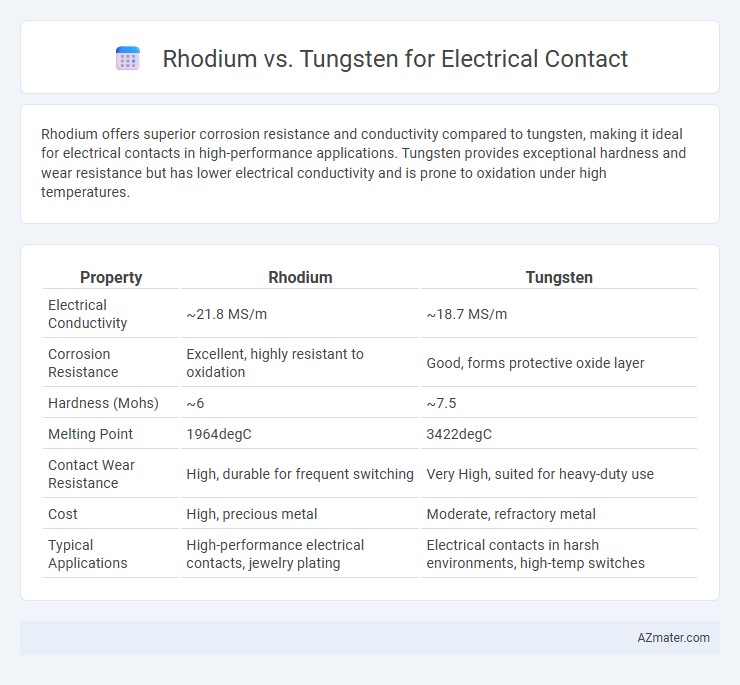Rhodium offers superior corrosion resistance and conductivity compared to tungsten, making it ideal for electrical contacts in high-performance applications. Tungsten provides exceptional hardness and wear resistance but has lower electrical conductivity and is prone to oxidation under high temperatures.
Table of Comparison
| Property | Rhodium | Tungsten |
|---|---|---|
| Electrical Conductivity | ~21.8 MS/m | ~18.7 MS/m |
| Corrosion Resistance | Excellent, highly resistant to oxidation | Good, forms protective oxide layer |
| Hardness (Mohs) | ~6 | ~7.5 |
| Melting Point | 1964degC | 3422degC |
| Contact Wear Resistance | High, durable for frequent switching | Very High, suited for heavy-duty use |
| Cost | High, precious metal | Moderate, refractory metal |
| Typical Applications | High-performance electrical contacts, jewelry plating | Electrical contacts in harsh environments, high-temp switches |
Introduction to Electrical Contacts
Electrical contacts require materials with excellent conductivity, wear resistance, and corrosion resistance to ensure reliable performance in electronic circuits. Rhodium offers superior corrosion resistance and low contact resistance, making it ideal for high-precision electrical contacts in switching applications. Tungsten provides exceptional hardness and high melting point, suitable for electrical contacts in high-temperature and high-current environments.
Key Properties of Rhodium
Rhodium exhibits exceptional electrical conductivity, superior corrosion resistance, and a high melting point of 1964degC, making it ideal for electrical contacts requiring durability and reliable performance under extreme conditions. Its hardness and resistance to oxidation ensure minimal contact resistance and long service life in harsh environments. Unlike tungsten, rhodium's stable chemical properties prevent surface degradation, maintaining consistent electrical connectivity over time.
Key Properties of Tungsten
Tungsten exhibits exceptional hardness and high melting point, making it highly durable for electrical contact applications where resistance to wear and heat is critical. Its excellent thermal and electrical conductivity ensures efficient current transfer while minimizing energy loss in demanding environments. Tungsten's low thermal expansion coefficient enhances dimensional stability under fluctuating temperatures, contributing to consistent performance in electrical contacts compared to rhodium.
Electrical Conductivity Comparison
Rhodium exhibits superior electrical conductivity compared to tungsten, making it a preferred choice for electrical contacts where efficient current flow is critical. Tungsten's electrical conductivity is significantly lower, typically around 17% of copper's conductivity, whereas rhodium offers conductivity closer to 70% of copper, enhancing performance in sensitive electrical applications. The higher conductivity of rhodium ensures reduced electrical resistance and improved durability in high-current and high-frequency contact scenarios.
Wear and Corrosion Resistance
Rhodium offers superior corrosion resistance and exceptional wear durability in electrical contacts due to its high hardness and inert chemical nature, making it ideal for harsh environments. Tungsten, while extremely hard and wear-resistant, is prone to oxidation at elevated temperatures, which can compromise long-term reliability. The choice between rhodium and tungsten hinges on application conditions, with rhodium preferred for corrosion resistance and tungsten favored for mechanical durability under heavy electrical loads.
Mechanical Strength and Durability
Rhodium offers superior corrosion resistance and hardness, making it highly durable for electrical contacts exposed to harsh environments. Tungsten provides exceptional mechanical strength and high melting point, ideal for applications requiring high wear resistance and thermal stability. Rhodium's resistance to oxidation enhances long-term conductivity, while tungsten's strength ensures structural integrity under mechanical stress.
Cost and Availability
Rhodium offers superior corrosion resistance and excellent conductivity but comes with a significantly higher cost due to its rarity and complex extraction processes. Tungsten provides a more cost-effective option with good electrical conductivity and high melting point, making it widely available and practical for mass production in electrical contacts. Availability of tungsten is more stable globally, whereas rhodium's limited supply in South Africa and Russia leads to price volatility and supply chain challenges.
Typical Applications in Electrical Engineering
Rhodium is favored for electrical contacts in high-reliability applications like aerospace and telecommunications due to its exceptional corrosion resistance and low electrical resistance. Tungsten, with its superior mechanical strength and high melting point, is commonly used in heavy-duty electrical switches and circuit breakers that require durability under high temperatures. Both metals offer excellent conductivity, but rhodium's surface hardness and oxidation resistance make it ideal for sensitive and precision electrical components.
Environmental and Safety Considerations
Rhodium offers superior corrosion resistance and lower electrical resistance compared to tungsten, reducing energy loss and increasing contact longevity in electrical applications. Tungsten, while highly durable and heat-resistant, poses greater environmental concerns due to its mining impact and potential toxicity if improperly handled. Both materials require careful disposal and recycling processes to minimize environmental contamination and ensure workplace safety.
Choosing Between Rhodium and Tungsten for Electrical Contacts
Rhodium offers superior corrosion resistance and excellent electrical conductivity, making it ideal for high-performance electrical contacts in harsh environments. Tungsten provides exceptional durability and thermal stability but has lower conductivity compared to rhodium, suitable for applications requiring high wear resistance under extreme conditions. Choosing between rhodium and tungsten depends on the specific electrical contact needs, balancing conductivity, environmental exposure, and mechanical stress.

Infographic: Rhodium vs Tungsten for Electrical Contact
 azmater.com
azmater.com